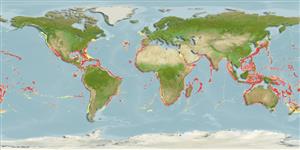Environment: milieu / climate zone / depth range / distribution range
Ekologi
laut dasar (demersal); kisaran kedalaman 200 - 1000 m (Ref. 58302). Subtropical; 52°N - 45°S
Western Atlantic: Newfoundland, Canada and northern Gulf of Mexico to Brazil (Ref. 7251). Eastern Atlantic: north-west Africa and the Canary Islands (Ref. 4777); also São Tomé Island (Ref. 34088). Not recorded from the Mediterranean and most of the eastern Atlantic (Ref. 9834). Indian and Pacific: widely distributed.
Size / Weight / umur
Maturity: Lm ? range ? - ? cm
Max length : 39.0 cm TL jantan/; (Ref. 4412)
Duri punggung (Keseluruhan (total)): 9 - 13; duri punggung lunak (Keseluruhan (total)): 24-28; Duri dubur 1-2; Sirip dubur lunak: 24 - 29; vertebrata, bertulang belakang: 41. Juveniles whitish or silvery with dark blue mottlings; pelvic fins black (Ref. 4412). Dark blue above, side silvery with patches of dark blue. Pelvic fin with inner rays joined to abdomen by membrane for its entire length (Ref. 26938).
Found offshore in warm waters. Juveniles pelagic in coastal and offshore waters down to at least 30 m, but adults possibly demersal in deep water (Ref. 9563). Occur in association with floating Portuguese man-of-war, Physalia, feeding on its tentacles and gonads and may drift with it into shore waters with proper wind conditions (Ref. 4777). Probably also feed on other soft-bodied jellyfish as well as on zooplankton (Ref.4777).
Life cycle and mating behavior
Kematangan | Reproduksi, perkembang biakan | Pemijahan | telur-telur | Fecundity | Larva
Haedrich, R.L., 1986. Nomeidae. p. 1183-1188. In P.J.P. Whitehead, M.-L. Bauchot, J.-C. Hureau, J. Nielsen and E. Tortonese (eds.) Fishes of the North-eastern Atlantic and the Mediterranean. UNESCO, Paris. Vol. 3. (Ref. 4777)
Status IUCN Red List (Ref. 130435)
ancaman kepada manusia
Harmless
penggunaan manusia
Warning: mysqli::__construct(): (HY000/1040): Too many connections in /var/www/html/includes/func_getlabel.php on line 46
Can't connect to MySQL database (fbapp). Errorcode: Too many connections
